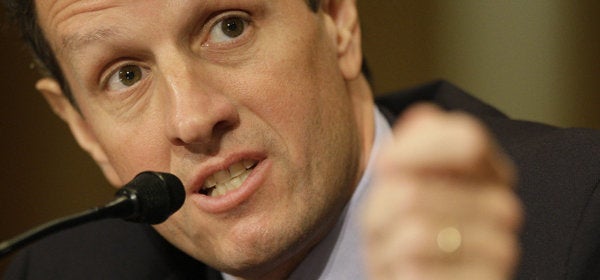
Nouriel Roubini, aka Dr. Doom, offers an excellent explanation of why Treasury Secretary Tim Geithner's latest brainstorm won't fix the banking system.
The bottom line is that someone has to take the losses on the $1+ trillion of depreciating assets that are still crushing bank balance sheets, and we taxpayers have woken up to the fact that we don't want it to be us. Geithner is therefore trying to find some way to stick us with the losses without our noticing, and this is easier said than done. Temporary receivership and restructuring is a much more effective way to go.
(Nouriel also makes his case without mentioning the most persuasive bit of evidence: The Geithner Plan is the same as The Hank Paulson Plan, just bigger, and The Hank Paulson Plan didn't work. Hard to be surprised that Geithner's sticking with it, though, inasmuch as he was likely the one who created it).
The very cumbersome U.S. Treasury proposal to dispose of toxic assets - that was presented by Treasury Secretary Tim Geithner... - can be best understood (subject to the large fog of uncertainty about its many details) as combining taking the toxic asset off the banks' balance sheet with providing government guarantees to those private investors that will purchase them (and/or public capital provision to fund a public-private bad bank that would purchase such assets).
But this plan is so non-transparent and complicated that it received a thumbs down by the markets as soon as it was announced today as all major US equity indices went sharply down.
The main problem with the Treasury plan - that in some ways it may resemble the deal between Merrill Lynch (ML) and Lone Star (LS) - is the following:
Merrill sold its CDOs to Lone Star for 22 cents on the dollar; and even in that case ML remained on the hook in case the value of the assets were to fall below 22 as LS paid initially only 11 cents (i.e. ML guaranteed the LS downside risk). But today a bank like Citi has similar CDOs that, until recently, were still sitting on its books, at a deluded and fake value of 60 cents. So, since the government knows that no one in the private sector would buy those most toxic assets at 60 cents it may have to promise a guarantee (formally or informally by putting capital into a public-private bad bank that will receive extra lending from the private sector) to limit the downside risk to private investors from purchasing such assets. But that implicit or explicit guarantee would be hugely expensive if you need to induce private folks to buy at 60 what is worth only 20 or even 11. So the new Treasury plan may end up being again a royal rip-off of the taxpayer if the guarantee is excessive given the true value of the underlying assets.
And if instead the implicit or explicit guarantee is not excessive (if the public-private bank truly tries to discover the value of such assets as in the formal Treasury proposal) the banks need to sell the toxic assets at their true underlying value that implies massive writedowns that will uncover the insolvency of such banks. I.e. the emperor has no clothes and a true valuation of the bad assets - without a huge taxpayers' bailout of the shareholders and unsecured creditors of banks - implies that banks are bankrupt and should be taken over by the government.
Once you understand this, it's no mystery why it's taking Geithner so long to develop the details of this plan. Now that the country has figured out that the whole story about "temporarily depressed market prices vs. intrinsic value prices" is just a crock designed to stick taxpayers with bank losses, it's harder to do that.
But someone has to take the losses. Which is why most smart economists are clamoring for temporary nationalization.